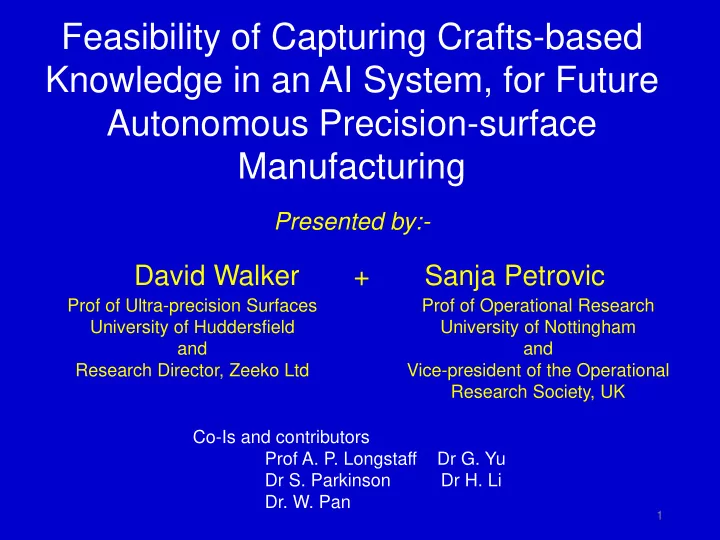

Feasibility of Capturing Crafts-based Knowledge in an AI System, for Future Autonomous Precision-surface Manufacturing Presented by:- David Walker + Sanja Petrovic Prof of Ultra-precision Surfaces Prof of Operational Research University of Huddersfield University of Nottingham and and Research Director, Zeeko Ltd Vice-president of the Operational Research Society, UK Co-Is and contributors Prof A. P. Longstaff Dr G. Yu Dr S. Parkinson Dr H. Li Dr. W. Pan 1
Defining the Problem • Burgeoning demand for complex, ultraprecision surfaces … better faster, cheaper • Standard CNC machining-centres not good enough • Hundreds of different materials. • Polishing:- rubbing process – limited predictability, so: • Iteration process metrology to converge on spec. • With advanced CNC, craft-expertise still needed to:- • define process for a new part/material • interpret metrology data and ‘tune’ the process • respond to unexpected process-events • know when to stop! Crafts-people retiring, in critical short-supply, and taking know-how with them! 2
Concept of Autonomous Manufacturing Cell. Historical data 3
Main steps in ultra-precision processing CNC Overall geometry + functional surfaces Grinding Output quality: ~ microns rms Functional surfaces Pre-polishing Remove surface & sub-surface damage Output quality: texture ~ 2 nm Sa, maintain input form Corrective Correct form-errors, maintain texture Output quality: few nm to 100nm rms Polishing abrasive particle Slurry complex hydrodynamic size distribution condition interactions at tool-part interface, dependent upon knowledge of removal mechanisms diversity of substrate materials tooling Polishing pad time Tool-path definition Speeds & feeds, force
How can we capture craft expertise ? • Interview - think aloud protocol • Watch them working (human or video) • Disciplined logging of process operations and decisions • Digital data-logging of:- • machine setup parameters • QR-codes on deployed tooling, fixtures etc • comprehensive real-time process-variables Questions for the future:- Who owns captured data, and inferred relationships ? Who has right of access, and right of use? What of remote-diagnostics? product enhancement? 5
What have we done? Project case study Three highly skilled craft-polishers and CNC machinists involved in a Project Case Study. Real part, real polishing … analyse all steps conducted Input part Diameter: 110mm Radius of Curvature: 269mm Material: BK7 material Shape: Concave spherical Think aloud protocol.
Resulting process flow-chart
Details of Section 3 Optimise tooling and/or NO (corrective-polishing) process-parameters Review Iteration Step 2 > 50% Meet ‘n’ Analyse Step 3 convergence NO the Step 1 error-map Clock rate? spec Measure YES the part Unexpected ? form artefacts? and data NO YES analysis Concentric to <150 End m? Adjus t part Legend Iteration n+1 support- and system YES require machinists’ skills NO Step 4 “Non -linear Tilts Step 7 Step 5 Step 6 YES probing” of <100 Compute Wash-down Polishing m? part tool-path part run
Error-map processing
Knowledge representation Case-based Reasoning System Data bases Case (optimise processing parameters) Materials Diameter Properties Thickness Density Radius curvature Young’s modulus Material (implies chemical, thermal and mechanical Thermal exp. coefficient properties) Fracture toughness Description of the error map Ductility index Chemical composition etc Solution: Parameters for the machine polishing software Polishing mode, Precess angle (degs), Head speed (rpm), Historical Process Tool offset (mm), Tool overhang (mm), Tool pressure (bar), Rotation (degs), Point spacing (mm), Track spacing (mm), Data Surface feed (mm/min) Design specifications Resulting error map Process parameters Real-time process data Metrology results Operator log
Similarity measure How relevant is a historical case to a new case? Part material determines tooling, process-conditions and removal-rate. Target 3D-form determines tool-path trajectory. k-neighbour similarity measures the weighted difference between feature values of the new case, and cases from the case-base. Too simple! Ontology To infer the level of similarity between two concepts, - how specific are the concepts/values, or - what is the level of commonality between two compared concepts?
Client Customer Future plans Requirements Architecture of Explanations AI Manufacturing Validator Cell Formal Process Plan Specs. Description Generation Deliberative Level Domain Model • Consistency, Adequacy, Safety-constraints Data Bases: • Situational- awareness Case Base Materials, Parts Operational • Causal operators Machines • Data ontologies Level In-process Process + Data Control Mining & Monitoring no Process yes Stop (Re-)Plan Client Trace Processing Process Description Explanations
Summary of project results Or, So What? Value : first insights into knowledge/skills of machinists that can realistically be captured from actual crafts operators. Impact : first steps to develop AI philosophy embodying capturing crafts expertise, underpins:- – future development of Autonomous Manufacturing Cell:- o Generate chains of operations o Explain behaviour and logic o Diagnose failures; avoid repeated mistakes o Self-improve through data-mining
Recommend
More recommend